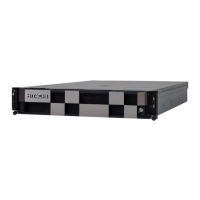TrueCopy, and from 0 to 255 are assigned to Universal Replicator and
global-active device. The consistency group numbers for Universal
Replicator are mapped to the journal.
Table 6-7 Assignment of consistency group IDs (CTG IDs)
CTG ID Assignment
0 -127 TrueCopy Asynchronous
TrueCopy
CTG 0-127
Universal Replicator
Global-active device
CTG 0-127
128 - 255 Universal Replicator
Global-active device
CTG 128-255
• At-time Split for TrueCopy: The operation for making data consistency
is only supported by the following option:
pairsplit -g <group> ... [-r]
pairsplit -g <group> ... -rw
TrueCopy Async and Universal Replicator volume characteristics
TrueCopy Async/Universal Replicator volumes have the following
characteristics:
• PAIR state: A TrueCopy Async pair changes to the PAIR status as soon as
all pending recordsets have been placed in the queue at the primary
volume, without waiting for the updates to complete at the secondary
volume.
• Pair splitting:When a TrueCopy Async pair is split or deleted, all pending
recordsets at the primary volume are sent to the secondary volume, then
the pair status changes to PSUS or SMPL. With the pairsplit command
only, updates for the primary volume that occur during and after the
pairsplit operation are marked on the bitmap of the primary volume.
• Pair resynchronization: The pairresync command resynchronizes the
secondary volume based on the primary volume. This resynchronization
does not guarantee the sequenced data transfer.
• Error suspending: Pending recordsets that have not yet been sent to the
secondary volume are marked on the bitmap of the primary volume, then
deleted from the queue, and then the pair status changes to PSUE.
• Group operations: TrueCopy Async automatically registers the CTG IDs
with the storage system when paired volumes are created using the
paircreate command, and groups in the configuration file are mapped to
their corresponding CTG IDs. If more than one group, defined in the
configuration definition file, is assigned to the same CTG ID, then pair
operations on the group specificity apply to the entire consistency group.
6-26
Data replication operations with CCI
Command Control Interface User and Reference Guide

